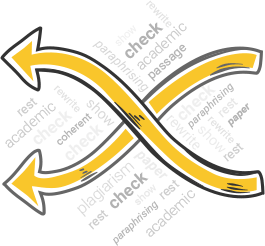Obligatory Components of Paraphrasing

-
Give credit to a source
- Use a direct reference to the author;
- Use quotation marks to specify the borrowed words;
- Use a full reference for the provided citation.

-
Rewrite in your words
- The paraphrased passage shouldn’t stand out but be coherent with the rest of your academic paper. How to do that?
- Modify the order
- Change the structure of the whole passage;
- Paraphrase single sentences;
- Split the compound sentences into simple ones and vice versa;
- Change the word order when appropriate.

- Add new material. That will support or tweak an original idea, as well as make the passage fit the context of your whole paper.
- Use your writing style. Make sure to write in your own words and phrases.

It’s okay to use shared language. Don’t use quotation marks when writing:
- Commonly-accepted vocabulary
- Conventional designations
- Bias-free language
- Tech-related terms and phrases
Additional Components of Paraphrasing

Caution!
Beware of synonymization. Easy to implement, this technique is overused. Several synonyms are acceptable, but excessive synonymization will turn your passage into nothing but pure plagiarism.
Details and examples
The correct paraphrasing is a topical issue for any writer. You do a research whatever piece you are working on, an essay or a blog post. It’s essential to support your original idea with statistics, scientific evidence and cold facts. Referring to these data, you still have to compose a unique text.
How do you safeguard your work from plagiarism?
Paraphrasing is putting the author’s text fragment into your own words. But to what extent should these words differ from the original? Let’s distinguish between unacceptable and legitimate paraphrase!
Word-to-word plagiarism
When using the text fragment is considered plagiarism? In case you keep the author’s original wording together with the sentence structure:
Original:
“New tracks aside, the challenge is at the bare minimum to bring light and air into these underground purgatory and, beyond that, to create for millions of people a new space worthy of New York, a civic hub in the spirit of the great demolished one, more attuned to the city’s aspirations and democratic ideals.” – Michael Kimmelman, The New York Times.
Paraphrase:
The problem is at the bare minimum to bring light and air into these underground purgatory and to provide millions of people a new space worthy of New York, a civic hub in the spirit of the great demolished one, more attuned to the city’s aspirations and democratic ideals.
If there’s a need to represent a text fragment as in original, you have to put words in quotation marks. For a citation, you have to use full reference.
On the other hand, using quotes is tricky. The concerned fragment would look incoherent even if we put the words in red into quotation marks.
Patchwork paraphrase
Your piece of writing is also considered as plagiarism in case you don’t divide the original word combinations from yours. You not only outline facts but borrow pieces of the author’s original language.
Original:
“New tracks aside, the challenge is at the bare minimum to bring light and air into these underground purgatory and, beyond that, to create for millions of people a new space worthy of New York, a civic hub in the spirit of the great demolished one, more attuned to the city’s aspirations and democratic ideals.” – Michael Kimmelman, The New York Times.
Paraphrase:
The problem is at minimum acceptable to bring light and air to the underground ravine and to provide city residents with a new space worthy of New York, a civic hub in the spirit of one pulled down, more appropriate for the city’s aspirations and democratic ideals.
Original:
“New tracks aside, the challenge is at the bare minimum to bring light and air into these underground purgatory and, beyond that, to create for millions of people a new space worthy of New York, a civic hub in the spirit of the great demolished one, more attuned to the city’s aspirations and democratic ideals.” – Michael Kimmelman, The New York Times.
Paraphrase:
One of the biggest issues facing Penn Station’s revitalization is developing a brighter, airier space. It is an abysmal “underground purgatory,” and with so many New Yorkers and tourists traveling in and out of its doors every day, should be reconstructed to better reflect the endeavors and passions of the city. (Kimmelman)
Learn to paraphrase legitimately
Comprehend the meaning of the original version to paraphrase it successfully. Understand the passage as a whole and decide what pieces are necessary for your work. Target at your audience. Then rewrite a piece in your unique language changing the syntactic structures. Add new material to fit context and purpose.
What’s the successful paraphrase outline? Here we go!
Change the structure
Focus on the subject matter of a passage. When the main idea is clear to you, change the paragraph structure. Add relevant material or edit the sentence order.
Continue with breaking the compound sentences into short ones or piece together some phrases of little length.
Depending on the context, shorten or extend certain phrases.
Original:
“According to Heat magazine, Miley has a list of intense rules for her men-to-be while out on dates. Apparently, her assistant arranges what the guy must wear, do, and talk about on the date. She’s also not into flowers, so he’s banned from bringing her those.”
Paraphrase:
As Heat magazine reports, Miley Cyrus has some bizarre rules for dating. She’s quite specific. Caring so much about what her dates wear, say, and do, she even has an assistant to enforce these rules on dates. Miley doesn’t like flowers either, and she won’t let guys buy them for her (“These Are Miley Cyrus’ Crazy Dating Rules”).
Change the words
You’ve altered the paragraph structure, but the text still has direct quotations? This happens when the specific terms and synonyms don’t naturally come to mind. So, let’s go to the next step!
Write in your own words and expressions. On this stage, you may introduce further changes to the structure of the sentence. Use other parts of speech. Alternate active and passive voice:
Original:
“A 68-year-old Gastonia man says he scared off two men in ski masks trying to break in his home with his gun he can keep on his walker. And then he taped a note to his door saying if they try to break into his house again, he will be waiting on them.”
Paraphrase:
Two men attempted to break into a home of a 68-year-old man. However, they were scared off by the gun he kept on the walker. Afterward, the man taped a note to the door warning that he’d be waiting for the burglars if they came back” (“Man Scares off Thieves with Gun on Walker”).
Don’t overplay with synonyms! Moderate utilization can be appropriate while the excessive use makes your writing similar to the bot generated text.
You can leave the shared language phrases unchanged and put no quotation marks. It includes the tech-related terms, conventional designations and bias-free language.
Tips on working with the source text
Make lists
You know this safe and proven method from school. When revising a source text, take notes. Paraphrase the source text in your notes. Make a list and use abbreviations. You will define the key insights and nonessential components. This method is effective when you need to analyze, memorize and rewrite a complicated text. It helps to represent your piece of writing in an original manner, starting out from the bottom line. Take handwritten or electronic notes, as you wish. The important thing is to keep notes well-organized. Highlight the important points with bright colors and give subheadings to the pages. And always write down the information source!
Look away from the text when writing
Read the text several times, until you feel ready to retell it. Do not consult the source when writing. Use the abbreviations and lists you’ve made. Write as much as you can looking away from the original text. Don’t refer to a source until you get to the most knotty issue. Consider the research process as a passive learning exercise. Writing tools can also help refine your ideas and improve originality – consider exploring G2’s guide on free writing software. Try to get emotionally involved and outline the most insightful aspects. Then set to writing. Create one bright and unique piece!
PlagiarismCheck.org is a one-stop resource for teachers, students, and writers who want to check plagiarism and AI. Try our free plagiarism checker now!







